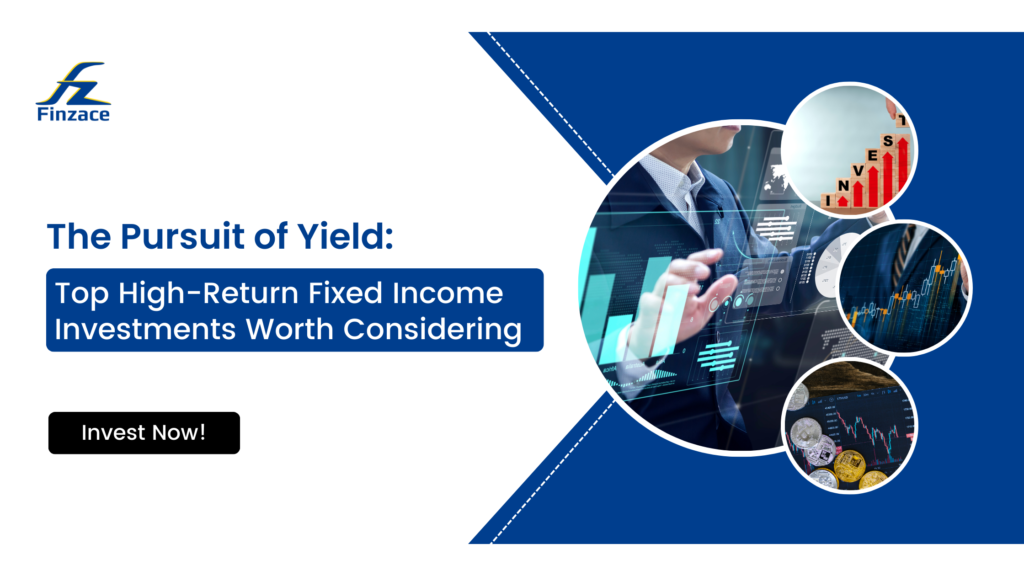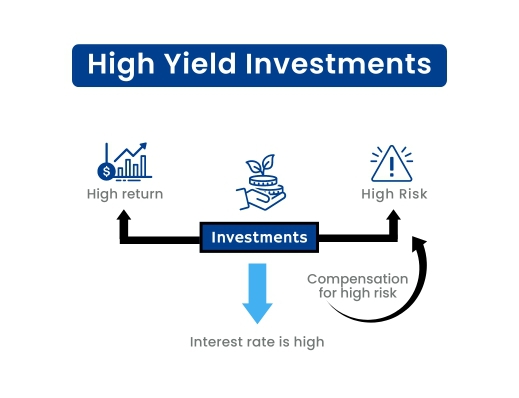The Pursuit of Yield: Top High-Return Fixed Income Investments Worth Considering

In today’s economic landscape, characterized by fluctuating interest rates and market volatility, investors are constantly on the lookout for stable, high-return fixed-income investments. These instruments not only provide a reliable income stream but also help diversify portfolios and mitigate risks. In this blog, we’ll delve into some of the top high-yield fixed-income investments worth considering in 2024, offering a detailed look at their benefits and potential returns.
| Investment Type | Description | Risk Level | Tax Considerations | Example |
| Corporate Bonds | Debt securities issued by companies. | Moderate to High | Taxable | XYZ Corporation bond rated BB with a 7% yield, yielding $700 annually on a $10,000 investment. |
| Municipal Bonds | Bonds issued by local and state governments, often tax-exempt. | Low to Moderate | Federal tax-exempt; state tax-exempt if resident | California municipal bond with a 3.5% yield, tax-equivalent yield of 4.5% for high tax bracket investors. |
| Treasury Inflation-Protected Securities (TIPS) | U.S. government bonds that adjust for inflation. | Very Low | Taxable | $10,000 TIPS with 1% base yield, effectively providing a 3% return in a year with 2% inflation. |
| Preferred Securities | Hybrid of equity and debt, often issued by financial institutions. | Moderate to High | Taxable | Preferred stock from a major bank with a 5.5% yield, yielding $1,100 annually on a $20,000 investment. |
| Emerging Market Bonds | Bonds issued by emerging market governments and corporations. | High | Taxable | Brazilian sovereign bond with an 8% yield, yielding $1,200 annually on a $15,000 investment. |
| High-Yield Savings Accounts and CDs | Bank products offering fixed returns and high liquidity. | Very Low | Taxable | 5-year CD with a 4.5% yield, yielding $1,125 annually on a $25,000 investment, with principal protected by FDIC insurance. |
1. Corporate Bonds
Debt instruments called corporate bonds are sold by businesses to raise money. Compared to government bonds, they usually have higher yields, especially when they come from companies with worse credit ratings.
– Investment Grade Corporate Bonds:
With yields ranging from 3% to 5%, these bonds offer a balanced risk-return profile and are rated BBB or above by major rating agencies. Investors desiring a modest level of risk can consider these.
– High-Yield (Junk) Bonds:
These bonds, which have a rating lower than BBB, provide greater yields in order to offset the higher risk. Higher risk-tolerant investors may find these bonds appealing due to their current yields, which can vary from 6% to 10%.
For instance, a BB-rated bond from XYZ Corporation offers a 7% yield, meaning that higher yields are obtained at the expense of increased credit risk. If there are no defaults, a $10,000 investment in this bond might yield $700 each year.
2. Municipal Bonds
Municipal bonds, or “munis,” are issued by local and state governments and are highly sought-after because they are exempt from federal taxes, as well as occasionally state taxes if the investor resides in the jurisdiction in which the bond is issued.
– General Obligation Bonds:
These bonds are usually quite secure because they are backed by the credit and taxing power of the issuing jurisdiction. Yields vary based on the period and credit grade, from 2% to 4%.
– Income Bonds: These bonds, which are backed by particular income streams like utility or toll collections, often have yields between 3% and 5% higher than general obligation bonds.
Example: For an investor in a high tax bracket, a 3.5% yielding California municipal bond may be comparable to a 4.5% yielding taxable bond. Munis are especially attractive because of their tax-equivalent income for individuals in the 30% tax band.
3. Treasury Inflation-Protected Securities (TIPS)
Treasury Inflation-Protected Securities (TIPS) are U.S. government bonds designed to protect investors against inflation. The extent to which TIPS primary values have been impacted by inflation is measured using the Consumer Price Index (CPI).
– Yields:
The inflation adjustment has the potential to significantly improve total returns, especially in conditions with high inflation, even though the base yield, which is now between 1% and 2%, may be lower. Using TIPS is the best method to keep your spending power intact.
For example, a $10,000 TIPS with a 1% base rate might theoretically rise to $10,300 in a year of 2% inflation by earning a 3% return. In terms of principal and interest payments, the investment may increase significantly over the course of ten years, assuming an average yearly rate of inflation of 2%.
4. Preferred Securities
Financial institutions regularly provide preferred securities, which mix elements of debt and equity. They are riskier, but the yields are larger than those of regular bonds and dividends from common stocks.
– Yields:
With potential ranges of 4% to 7%, these are attractive to income-focused investors. Preferred securities sometimes provide fixed dividends, which provide steady income.
For example, compared to common equities, a large bank’s 5.5% earning preferred shares offers steady income with relatively low risk. A $20,000 investment would generate $1,100 in revenue each year.
5. Emerging Market Bonds
Because these regions carry larger political and economic risks, emerging market bonds have the potential to yield higher rates.
– Sovereign Bonds:
Usually yielding between 5% and 8%, these bonds are issued by governments in emerging markets. Because of their minimal correlation with developed market securities, they provide benefits related to diversification.
– Corporate Bonds:
Due to the increased risk, these bonds, which are issued by businesses in these markets, can have yields between 6% and 10%.
For instance, the 8% yield on a Brazilian national bond represents both the increased risk and the possibility of larger returns in emerging economies. A $15,000 investment in such a bond may yield $1,200 yearly, with further capital gain possibilities should the nation’s economic circumstances improve.
6. High-Yield Savings Accounts and CDs
Certificates of deposit (CDs) and high-yield savings accounts offer safer options with guaranteed returns.
– High-Yield Savings Accounts:
These accounts give simple access to funds, safety and liquidity, and interest rates ranging from 3% to 4%.
– CDs: CDs have fixed interest rates and maturities that range from a few months to several years. Depending on the duration of the contract and the issuing bank, current returns might range from 3.5% to 5%.
For example, a 4.5% yielding 5-year CD guarantees a fixed return during the term, making it the perfect choice for conservative investors. A $25,000 investment in one of these CDs would earn $1,125 a year, with the FDIC insuring the principal up to the relevant restrictions.
Achieving yield requires striking a balance between risk and reward. Investors can attain consistent and possibly high returns by diversifying their fixed income assets across a range of asset classes, including corporate bonds, municipal bonds, TIPS, preferred securities, emerging market bonds, and high-yield savings accounts or certificates of deposit. To ensure that these assets meet your unique needs, always take your risk tolerance, investment horizon, and advice from a financial advisor into account.
Understanding the risk-return trade-off and diversifying properly to control risk while chasing greater returns are essential to effective fixed income investing. For individuals looking to improve their income portfolios in 2024, these high-return fixed income choices provide excellent prospects.

Conclusion:
Balancing risk and return is crucial in the pursuit of yield. By diversifying across various types of fixed income investments—corporate bonds—investors can achieve stable and potentially high returns. Always consider your risk tolerance, investment horizon, and consult with a financial advisor to tailor these investments to your specific needs.
Discover Finzace: Your Partner in High-Yield Investing
At Finzace, we specialize in helping you find the best fixed return investment in India and high return fixed income investments globally. Our app offers a comprehensive range of low risk investment options in India, including secured investment options and the best safe investments with high returns.
For those seeking the best short-term fixed income investments or exploring investment in NCDs (Non-Convertible Debentures), Finzace provides detailed insights and expert guidance. High-yield corporate bonds and other high-return fixed-income instruments are easily accessible through our platform.
Download Finzace today and start building a diversified portfolio with the best fixed-return investments, secured options, and expert advice tailored to your needs. Secure your financial future with Finzace, your trusted partner in high-yield investing.
Download link (Android): https://play.google.com/store/apps/details?id=icreditspace.com
Download link (Apple): https://apps.apple.com/in/app/finzace-earn-12-returns/id6446245952
